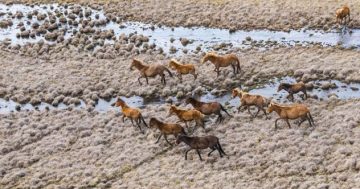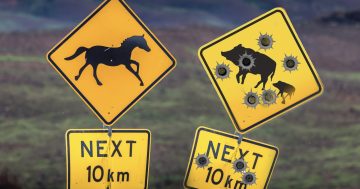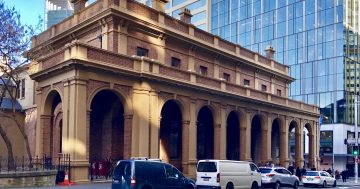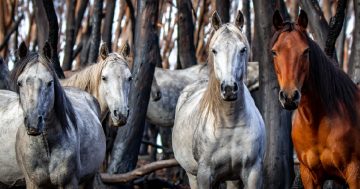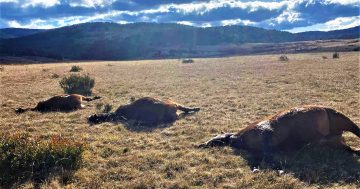
It’s easy to understand the affection many have for the brumby. Photo: Taken at Currango Plains in the Kosciuszko National Park, supplied.
When it comes to the poetry of Banjo Paterson I am more ‘Mulga Bill’s Bicycle’ than ‘Man From Snowy River’.
Twas Mulga Bill, from Eaglehawk, that caught the cycling craze;
He turned away the good old horse that served him many days;
He dressed himself in cycling clothes, resplendent to be seen;
He hurried off to town and bought a shining new machine…
It was a picture book in primary school that first introduced Paterson’s character to me, and as a father, I have relished reading it aloud to my three kids, sadly they are too old for that now.
This week the connection and fondness many have for the brumbies of ‘The Man From Snowy River’ was recognised at the highest level with the NSW Deputy Premier and Member for Monaro, John Barilaro flagging his intention to “protect the heritage value and cultural significance of the Snowy Mountains brumby.”
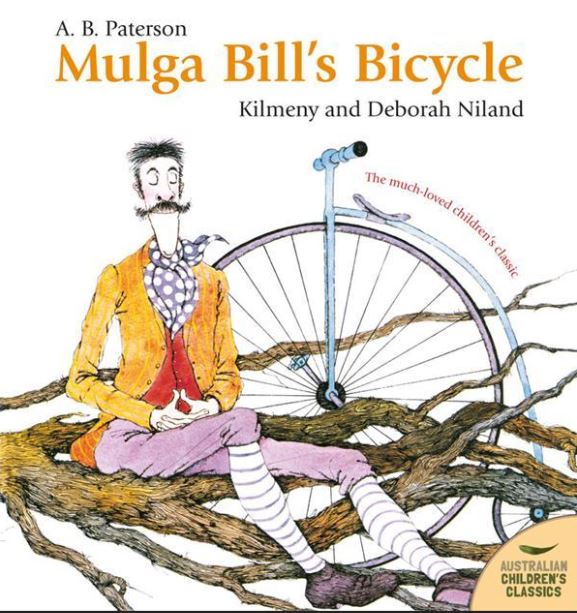
The Mulga Bill’s Bicycle picture book, great memories! Photo: Booktopia.
“Wild brumbies have been roaming the Australian Alps for almost 200 years and are part of the cultural fabric and folklore of the high country,” Mr Barilaro said.
“The Minister for the Environment and I will introduce a Bill into the NSW Parliament that will recognise the heritage value of the brumby in Kosciuszko National Park and set a framework for protecting it,” he said.
Dubbed the ‘Brumby Bill’, the new laws will require Minister Gabrielle Upton to prepare a heritage management plan for the brumby, which will identify areas within the Kosciuszko National Park where populations will be maintained, and set rules around brumby management.
Mr Barilaro said the new laws will finally end years of speculation around aerial culling which was identified as one of the preferred control methods by the Government’s own Independent Technical Reference Group set up in 2014 to offer advice on the issue to the National Parks and Wildlife Service.
“The heritage management plan will specifically prohibit lethal culling of the brumby, aerial or otherwise, and will identify those areas in the park where brumbies can roam without causing significant environmental harm,” Mr Barilaro said.
“If brumbies are found in highly-sensitive alpine areas of Kosciuszko National Park, resources will be allocated towards relocation first, followed by re-homing, should population numbers grow too high.
“Kosciuszko National Park exists to protect the unique environment of the Snowy Mountains, and that unique environment includes wild brumbies,” he said.
The legislation will also require all future plans of management for Kosciuszko to recognise the cultural significance of the brumby.
Other changes will include:
- The establishment of a Wild Horse Community Advisory Panel to advise the Environment Minister of appropriate management approaches for the brumby;
- A research and monitoring program that scientifically informs future wild horse management plans;
- A brumby count to gain a more accurate assessment of brumby numbers and where they range;
- A marketing campaign to promote re-homing and adoption of brumbies that need to be removed from the park.
BRUMBIES BILL: New legislation to recognise and protect the heritage and cultural value of the Snowy Mountains brumbies. A historic day.
Posted by John Barilaro on Sunday, May 20, 2018
In addition to the Brumby Bill, the NSW Government this week approved horse riding on dedicated trails within four national parks – Kosciuszko, Deua, Monga, and Mummel Gulf; following a two-year trial and monitoring, which according to Mr Barilario showed horse riding caused minimal impacts where it occurred.
“I thank the community for its patience during the trial which ran from April 2014 to April 2016, and am pleased the study found the environmental impacts of the horse riding, which has been carried out on set tracks for years, were minimal,” Mr Barilaro said.
Cobargo horseman Richard Tarlinton was part of the trial and is delighted with the news.
“Personally it’s a wonderful feeling to be out there, for me it’s like going to church, you are there with god,” he told About Regional.
These trails were used in the pioneering days of colonisation in South East NSW and in many cases took advantage of existing Aboriginal pathways.
That shared cultural history is part of the magic of these routes for Mr Tarlinton, whose own family developed and used these trails in their own agricultural enterprise.
Mr Tarlinton acknowledges that having horses in a native environment like Kosciuszko, Deua, Monga, and Mummel Gulf National Parks comes with responsibility, “One of the main things you’ve got to do is stick to the tracks,” he says.
“And you feed them chaff, so there’s no weed going into that area.”
Mr Barilaro says final arrangements formalising the horse riding trails in the four national parks should be ready by December 2018 when the consultation process and amended plans of management are complete.
The question I am left with – why isn’t that isn’t enough?
Why do brumbies still need to be allowed to roam free in sections of Kosciuszko National Park in order recognise and celebrate European history?
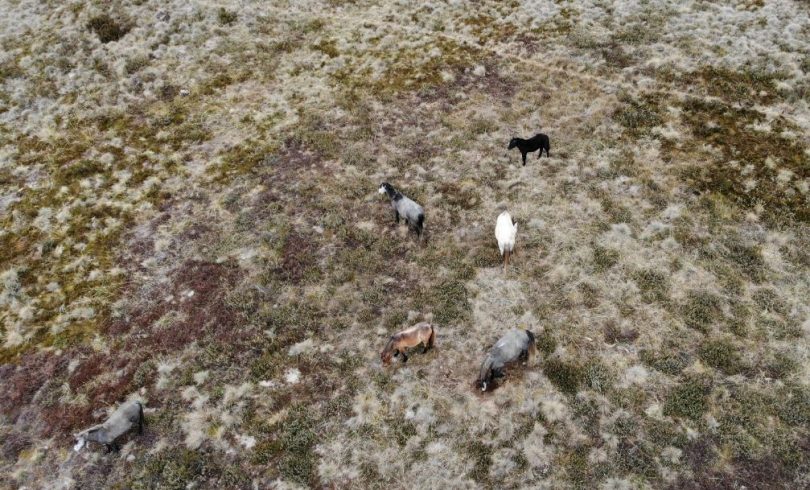
Brumbies at Currango Plains in the Kosciuszko National Park, taken May 19, 2018. Photo: Supplied.
Speaking to RN Breakfast, Mr Barilaro said allowing a managed population of wild brumbies to stay in the park was recognition that there is a cultural connection to the feral horses.
“They have been part of that landscape for almost 200 years, part of folk law, the heritage, the culture of our nation, showcased at the opening of the Olympic Games and at the same time a connection to the Walers that went overseas for the war effort,” he said.
“What we are doing is enshrining in law that cultural and heritage connection to the Park.”
“We accept that those horses do have a right and a home in the Park,” Mr Barilaro said.
The Deputy Premier acknowledges that brumbies need to be managed in the park and has put his confidence in the new Wild Horse Community Advisory Panel to do that.
This week’s announcement points to a need for further science and study to guide the work of the Advisory Panel, however it seems much is already known; knowledge established in a large part by research commissioned by the NSW Government.
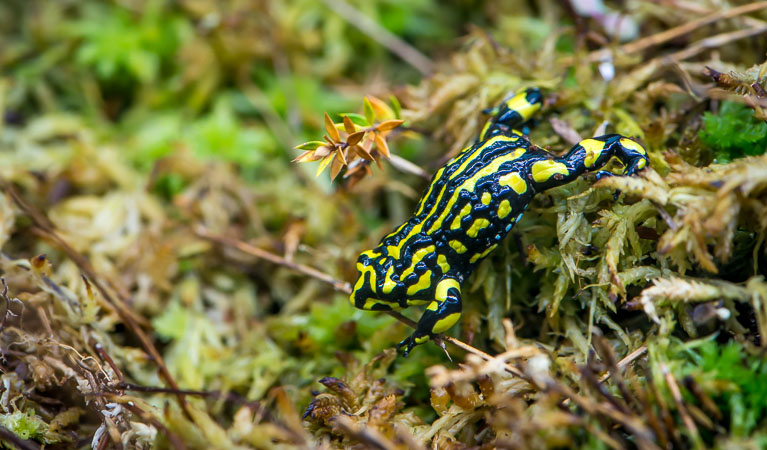
Southern Corroboree Frog withing Koscusizko National Park. Photo: NSW National Parks.
In August 2016, 41 Australian ecologists wrote to the then NSW Premier, Mike Baird calling for a rapid reduction in wild horse numbers in Kosciuszko.
“Horses are stock animals recently introduced and are not characteristic of this area, but threaten ecosystem processes, ecosystems, and species that are characteristic,” the letter said.
“Horses are not compatible with the primary goal of nature conservation in a national park.”
The group which spans 16 universities in Queensland, New South Wales, Australian Capital Territory, Victoria, and Tasmania, urged the NSW Government to keep best practice aerial culling on the table in order to support the conservation of native fauna and flora.
The concerned group of scientists suggested around 600 brumbies might be a more manageable number as opposed to the estimated 6,000 living in Kosciuszko in 2016, but they stressed the need for a rapid decline in those numbers.
More recently the NSW Threatened Species Committee, which is appointed by the NSW Environment Minister pointed to 23 plant species, and eight (8) animal that were “likely to be adversely affected by feral horses,” including the Southern Corroboree Frog, Guthega Skink, Alpine Spiny Crayfish, and Mountain Pygmy Possum.
“Habitat damage in streams, wetlands and adjacent riparian systems occurs through selective grazing, trampling, track creation, pugging (soil compaction), wallowing, [and] dust bathing leading to stream bank slumping and destruction, stream course disturbance and incision and sphagnum bog and wetland destruction,” writes Committee Chair, Dr Marco Duretto.
“Feral horses impact a wide range of ecological communities across the Australian Alpine region of NSW, a declared UNESCO Biosphere Reserve.”
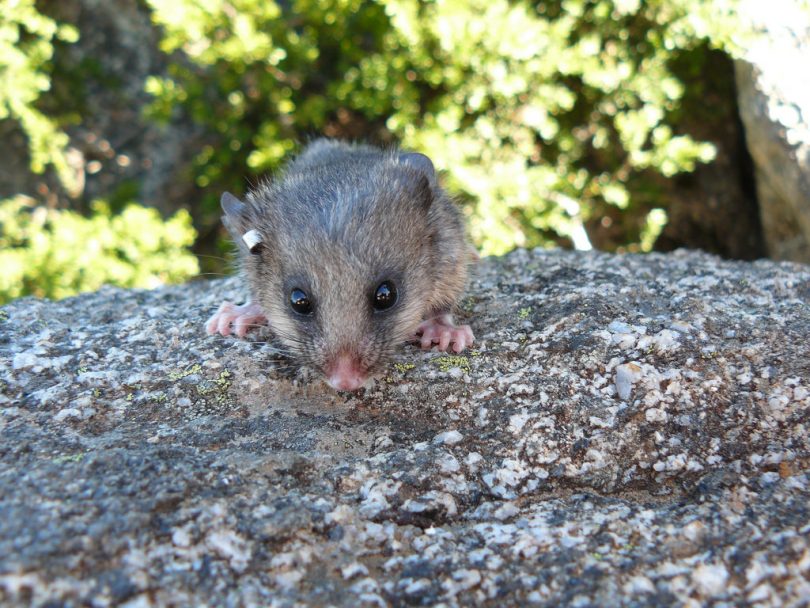
Mountain Pygmy Possum. Photo: NSW Environment and Heritage.
The Deputy Premier has rejected suggestions that his government is ignoring scientific advice, telling RN’s Hamish MacDonald, “Part of leadership is finding a balance and I think we are finding a balance.”
“[We] are now finding a way forward through an advisory committee with a range of different stakeholders to work through the data, the information at hand, look for new data and look for new control methods,” he said.
One of the 41 concerned scientists who wrote to the government in August 2016 hopes the science will get a better hearing in parliament when the Brumby Bill is introduced in the coming days.
“If the parliament accepts the legislation then its a real slap in the face for NSW voters,” Professor Don Driscoll, from Deakin University said.
“Because their premier National Park is going to be degraded over the coming decades.
“There is no safe place to put these horses inside the National Park where they won’t have an impact,” Professor Driscoll said.
Recognising the significance of a “brumby culture” in the community, the ecologist is keen to see alternative ideas explored.
“Cultural affiliation with horses is widespread around the world, including in the US, Spain and many South American countries, Professor Driscoll said.
“Australia is no exception, epitomised by the poem ‘The Man from Snowy River’ by Banjo Paterson.
“Culture can be celebrated in a range of ways. We don’t celebrate the Gallipoli landing using actual violence, we don’t celebrate anniversaries of the moon landing by sending astronauts there,” he said.
The Mulga Bill Bicycle Trail established by the Eaglehawk community near Bendigo is a good example of celebrating culture, and along the lines suggested by Professor Driscoll.
If our cultural celebration of the brumby is to include horses left to roam the Snowy Mountains then evidence suggests we need to accept that the Southern Corroboree Frog and Mountain Pygmy Possum will perhaps go the way of Mulga Bill and his bicycle and end up in Dead Man’s Creek.
*This article first appeared on RiotACT










